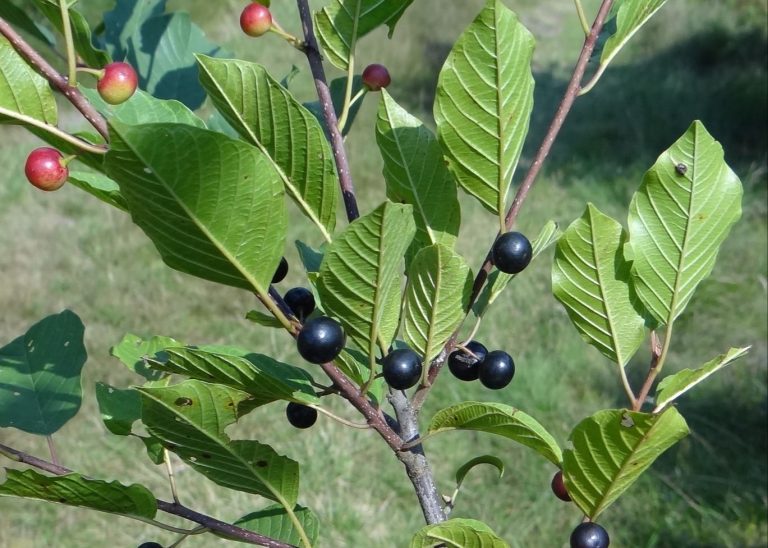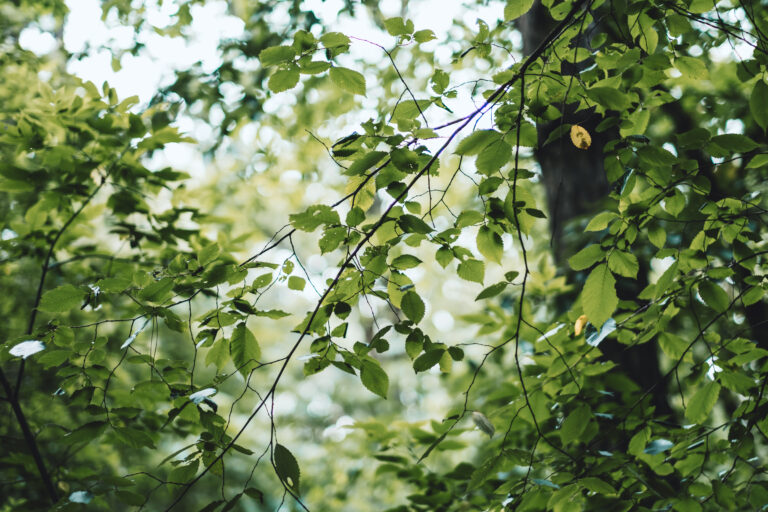Table of Contents
Types of Buckthorn
Before diving into identification, it’s important to know that there are two primary species of invasive buckthorn in North America:
Common Buckthorn (Rhamnus cathartica) – Found in forests, fields, and roadsides, this species grows as a large shrub or small tree up to 25 feet tall.
Glossy Buckthorn (Frangula alnus) – Prefers wetter environments such as wetlands and riverbanks. It lacks the small thorns that are present on common buckthorn.
Both species exhibit similar growth patterns and have negative effects on native ecosystems.
How to Identify Buckthorn
1. Leaves
Buckthorn’s leaves are one of its most recognizable features. Look for the following characteristics:
-
Common Buckthorn: Dark green, oval-shaped leaves with finely serrated edges and an alternate or nearly opposite arrangement on the stem. Veins curve toward the leaf tip.
-
Glossy Buckthorn: Smooth, oval leaves with a shiny surface and no serration. They remain green well into late fall, giving buckthorn a competitive advantage over native plants.
Both species retain their green leaves much longer than most native trees, making them easy to spot in autumn. If you’d like to learn more about these topics, then read our blogs Identifying Buckthorn in your Woodlands: 5 Obvious Signs and 7 Ways to Effectively Remove Buckthorn.
2. Bark and Twigs
Buckthorn bark and twigs offer another way to distinguish it from native trees and shrubs:
The bark is dark gray to brown with a rough, slightly flaky texture.
When scraped or cut, the inner bark reveals a distinctive yellow-orange layer, which is a key identifying feature.
The twigs of common buckthorn often end in a small, sharp thorn, giving the plant its name.

3. Berries and Seeds
Buckthorn produces berries that contribute to its rapid spread:
Small, black berries appear in clusters along the stems in late summer and persist into winter.
While these berries are toxic to humans, birds consume them, leading to widespread seed dispersal.
The seeds are highly viable and can remain in the soil for several years, making eradication difficult.

4. Growth Pattern and Habitat
Buckthorn’s growth habits allow it to dominate woodlands:
It typically grows as a dense, shrubby thicket or a small tree up to 25 feet tall.
The plant thrives in a variety of conditions, from dry forests to wetlands, disturbed areas, and roadsides.
It forms a dense understory, preventing the growth of native plants and young trees by blocking sunlight.

Why Identifying Buckthorn Matters
-
Buckthorn is not just an eyesore—it has severe ecological consequences:
-
Suppresses native plant growth by creating shade and altering soil chemistry.
-
Harms wildlife by replacing native food sources with its low-nutrient berries.
-
Reduces biodiversity by forming monocultures where only buckthorn thrives.
-
Increases soil erosion by disrupting the natural balance of plant roots in an ecosystem.
By identifying and removing buckthorn, you can help protect native plants, improve habitat quality, and restore the natural balance of your woodlands. If you want to read more about buckthorn removal tools and average costs for buckthorn removal then read our blog Special Tools for Removing Buckthorn: 5 Failproof Choices and Price Guide for Buckthorn Removal: Average Costs in 2025
-
How to Confirm Buckthorn Presence
Scratch the bark – If it reveals a bright yellow-orange inner layer, it’s likely buckthorn.
Check the berries – Small, black, clustered berries appearing in late summer and fall are a strong indicator.
Observe leaf retention – Buckthorn holds its green leaves longer than most native trees in fall.
If you suspect buckthorn in your woods but aren’t sure, try these simple tests:



